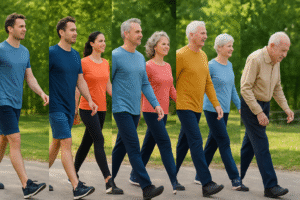
Walking is one of the simplest yet most powerful exercises for lifelong health. But how much should you walk daily? The answer depends on age, gender, and health goals. Experts suggest that the ideal walking steps per day vary across age groups—whether you’re in your 30s, 40s, or 50s, or even a senior looking for a safe walking routine for elderly health. For young adults, a brisk walking routine of 8,000–10,000 steps helps build stamina and manage weight, while those above 50 benefit more from moderate pacing to protect joints and improve flexibility. In fact, a walking plan for men and women by age group not only boosts fitness but also prevents lifestyle conditions like diabetes, high blood pressure, and heart disease. Choosing the right daily walking time by age group makes walking a perfect balance between exercise and longevity.
For women, walking has unique benefits—it supports hormonal balance, bone strength, and cardiovascular health. Men can focus on combining brisk walking benefits with strength training for better stamina. Seniors should prioritize walking for diabetes control, walking to lower blood pressure, and enhancing balance to reduce fall risks. Even small adjustments—like deciding between a morning vs evening walk—can influence metabolism, energy, and sleep. Compared to jogging, walking is safer, more sustainable, and equally effective for heart health and weight loss when done with the right walking intensity. Ultimately, following walking recommendations by age and gender ensures you enjoy the best of both worlds: a safe, age-appropriate fitness plan and the countless health benefits of daily walking.
Here’s a detailed guide to help you find the right walking routine for better health.
🔹 Age 20–30 (Young Adults)
👨 Male
Duration: 45–60 minutes daily (or 10,000+ steps)
Intensity: Brisk walking (6–7 km/h), include uphill walks or intervals
Goal: Build stamina, manage weight, relieve stress
👩 Female
Duration: 40–50 minutes daily (8,000–10,000 steps)
Intensity: Brisk to moderate pace (5.5–6.5 km/h)
Goal: Weight control, cardiovascular health, hormonal balance
🔹 Age 31–40 (Early Middle Age)
👨 Male
Duration: 40–50 minutes daily
Intensity: Brisk walk, mix with light jogs if comfortable
Goal: Stress management, prevent lifestyle diseases (BP, diabetes)
👩 Female
Duration: 35–45 minutes daily
Intensity: Moderate to brisk pace (5–6 km/h)
Goal: Weight management, bone health, stress relief
🔹 Age 41–50 (Midlife)
👨 Male
Duration: 35–45 minutes daily (7,000–9,000 steps)
Intensity: Moderate pace (5.5–6 km/h), brisk 2–3 days per week
Goal: Control cholesterol, manage BP, maintain fitness
👩 Female
Duration: 30–40 minutes daily
Intensity: Moderate pace (5–5.5 km/h), avoid overstrain
Goal: Support metabolism, prevent osteoporosis, reduce stress
🔹 Age 51–60 (Pre-senior)
👨 Male
Duration: 30–40 minutes daily (6,000–8,000 steps)
Intensity: Moderate, maintain heart rate at 60–70% of max
Goal: Maintain joint mobility, strengthen the heart
👩 Female
Duration: 25–35 minutes daily
Intensity: Moderate pace (4.5–5 km/h)
Goal: Strengthen bones, prevent post-menopause weight gain
🔹 Age 61–70 (Seniors)
👨 Male
Duration: 25–35 minutes daily (5,000–7,000 steps)
Intensity: Comfortable pace (4.5–5 km/h)
Goal: Prevent stiffness, maintain balance, control sugar & BP
👩 Female
Duration: 20–30 minutes daily
Intensity: Slow to moderate pace (4–4.5 km/h), flat surface preferred
Goal: Preserve joint health, improve flexibility, encourage social wellbeing
🔹 Age 71 & Above (Elderly)
👨 Male
Duration: 15–25 minutes daily (3,000–5,000 steps)
Intensity: Gentle pace (3.5–4.5 km/h), can be split into 2–3 short sessions
Goal: Maintain mobility, prevent falls, support mental health
👩 Female
Duration: 15–20 minutes daily
Intensity: Slow pace, use support if needed
Goal: Independence, reduce fracture risk, boost mood
✅ General Tips for All Ages
Begin with a 5-minute warm-up and end with a cool-down.
Wear comfortable walking shoes.
Stay hydrated before and after your walk.
For weight loss → walking before breakfast or after meals works best.
For better sleep → a gentle evening walk can help relax your body.
+
🌟 Final Thought
Walking is not just exercise; it’s a lifelong habit that supports both body and mind. Whether you are in your 20s or 70s, choosing the right duration and intensity can help you live healthier, stronger, and happier.
